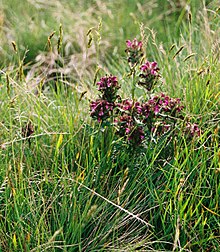
Pedicularis dasyantha, the woolly lousewort or arctic hairy lousewort, is a plant native to the high arctic areas of Svalbard, Novaya Zemlya and the bordering mainland, and the western Taymyr Peninsula. In Svalbard it is restricted to the main island, Spitsbergen.
There are over 190 vascular plant species on the Norwegian Arctic archipelago of Svalbard. This figure does not include algae, mosses, and lichens, which are non-vascular plants. For an island so far north, this number of species constitutes an astonishing variety of plant life. Because of the harsh climate and the short growing season, all the plants are slow growing. They seldom grow higher than 10 cm (4 in)
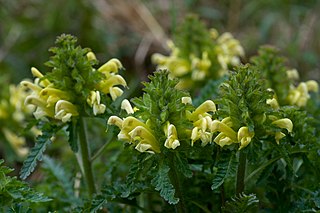
Pedicularis canadensis, commonly called Canadian lousewort or wood betony, is a flowering plant in the family Orobanchaceae. It is native to North America, where it is found in southeastern Canada, the eastern United States, and eastern Mexico. It has a wide-ranging natural habitat, being found in mesic to dry, forests, woodlands, and prairies.
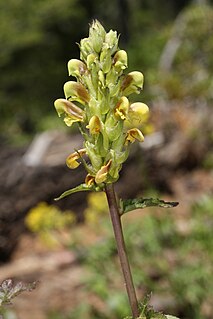
Pedicularis is a genus of perennial green root parasite plants currently placed in the family Orobanchaceae.

Woolly lousewort is a common name for several plants and may refer to:

Junkerdal National Park is a national park that lies in the municipalities of Saltdal and Fauske in Nordland county, Norway, along the border with Sweden. The 682-square-kilometre (263 sq mi) park was opened in 2004. The park borders the Junkerdalsura nature reserve.

Catherine 'Kate' Furbish was an American botanist who collected, classified and illustrated the native flora of Maine. She devoted over 60 years of her life, traveling thousands of miles throughout her home state and creating very accurate drawings and watercolor paintings of the plants she found.

Pedicularis furbishiae, or Furbish's lousewort, is a perennial herb found only on the shores of the upper Saint John River in Maine and New Brunswick. Furbish's lousewort was first recognized as a new species by Maine naturalist and botanical artist Kate Furbish in 1880. It is considered an endangered species in the United States and Canada, and is threatened by habitat destruction, as well as riverside development, forestry, littering and recreational use of the riverbank. It was formerly in the family Scrophulariaceae, but is now placed in the family Orobanchaceae.

Pedicularis groenlandica is a showy flowering plant in the family Orobanchaceae which is known by the common names elephant's head and elephanthead lousewort. This erect plant can grow to a height of 80 centimetres (31 in). Its sharply-toothed fernlike leaves are located low on the stout stem. The stem is topped with a large inflorescence of bright pink to purple or white flowers. Each flower has a long, pointed beak which curves upward, superficially resembling the trunk of an elephant, and the lateral lobes of the flower resemble an elephant's ears. Like other louseworts and related broomrape genera, this is a root parasite which obtains nutrients from the roots of other plants by piercing them with haustoria. This plant is found in the high mountain ranges of western North America, particularly the Cascades and High Sierra, much of Canada and Greenland. It grows in wet environments such as riverbanks.

Pedicularis centranthera is a species of flowering plant in the family Orobanchaceae known by the common names dwarf lousewort and Great Basin lousewort. It is native to the western United States from eastern Oregon and California to Colorado and New Mexico, where it grows in sagebrush and other basin and plateau habitat. It is a perennial herb producing several short stems a few centimeters tall from a basal caudex. The leaves are up to 20 centimeters long, lance-shaped and divided into many overlapping toothed, wrinkled, or fringed lobes. The inflorescence is a short raceme bearing many long, protruding, club-shaped flowers. Each flower may exceed 4 centimeters in length and is white or pale purple with dark purple tips on the wide ends of its upper and lower lips. The sepals of the flowers are shorter and hairy. The fruit is a capsule around centimeter long containing seeds with netlike surfaces.

Pedicularis contorta is a species of flowering plant in the family Orobanchaceae known by the common names coiled lousewort and curved-beak lousewort. It is native to western North America, including southwestern Canada and the northwestern United States, where it grows in moist mountainous habitat, such as bogs, shady forests, and meadows. It is a perennial herb producing one or more stems up to 40 centimetres (16 in) tall from a caudex. The leaves are up to 18 centimetres (7.1 in) long, lance-shaped to oblong, and divided into many linear lobes which may be toothed or smooth-edged. The inflorescence is a raceme of flowers occupying the top of the stem. Each flower is a centimeter long or slightly longer, white to yellowish in color, and divided into a coiled or curved beak-like upper lip and a flat, three-lobed lower lip. The fruit is a capsule up to a centimeter long containing seeds with netted surfaces.
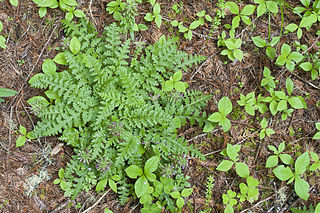
Pedicularis dudleyi is a rare species of flowering plant in the family Orobanchaceae known by the common name Dudley's lousewort. It is endemic to central California, where it is known from about ten scattered occurrences along the coast and in the coastal mountain ranges. It has been found in three locations along the Central California coast. The species was named for 19th-century Stanford University botanist William Dudley.
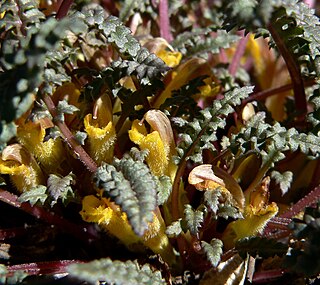
Pedicularis semibarbata, known by the common name pinewoods lousewort, is a species of flowering plant in the family Orobanchaceae.

Pedicularis verticillata, the whorled lousewort, is a species of flowering plant in the family Orobanchaceae which can be found in Alaska, North-Western Canada, and everywhere in China at the elevation of 2,100–4,400 metres (6,900–14,400 ft).

Pedicularis lanata is a species of flowering plant in the family Orobanchaceae. It is native to Canada and Alaska. Its common names include woolly lousewort and bumble-bee flower.

Pedicularis lanceolata, the swamp lousewort, is a species of flowering plant native to the Midwestern and Northeastern United States and southern Canada. It is most often found in base-rich wetlands such as fens, springs, and wet meadows.
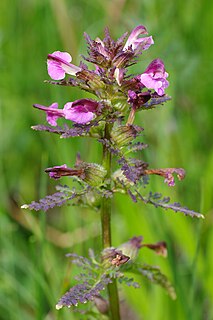
Pedicularis palustris, commonly known as marsh lousewort, is a plant species in the family Orobanchaceae. It is native to central and northern Europe and Asia where it grows in wetlands and boggy habitats. The International Union for Conservation of Nature has assessed its conservation status as being of least concern.
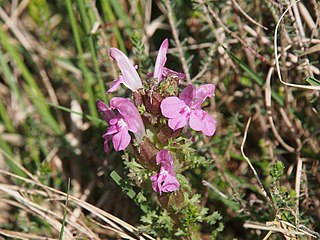
Pedicularis sylvatica, commonly known as common lousewort, is a plant species in the genus Pedicularis. It is native to central and northern Europe where it grows on moist acidic soils, moorland, grassy heathland and the drier parts of marshes.

Pedicularis hirsuta, commonly known as Hairy Lousewort, is a species of flowering plant belonging to the family Orobanchaceae.
